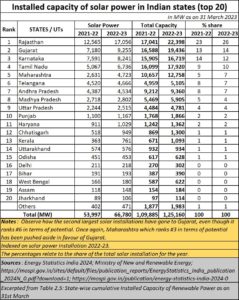A new policy direction for solar is required in India
By RN Bhaskar
If one goes by statements and posturing, India is the best visionary for solar. Remember how the government announced its
Too many announcements
Just consider the number of statements and promises made.
- The first announcement was made bout its solar plans solar plans on June 30 2008 (https://archivepmo.nic.in/drmanmohansingh/speech-details.php?nodeid=667).
- The government then launched the National Solar Mission I on January 11, 2010 (https://archivepmo.nic.in/drmanmohansingh/speech-details.php?nodeid=848).
- The current government made a policy announcement on rooftop solar on 10 June 2014 (https://asiaconverge.com/2016/06/solar-power-govt-takes-bolder-steps-finally/). The policy involved asking all government buildings to set up solar panels on their rooftops, and encouraging houses to put up such panels as well. Little was achieved on this front.
- You also had Prime Minister Modi launching the International Solar Alliance (https://isolaralliance.org/). The initiative was first proposed in a speech in November 2015 at Wembley Stadium in London (https://www.indiatoday.in/india/story/pm-modi-in-uk-full-text-of-pm-modis-speech-at-british-parliament-272559-2015-11-12).
- Then, in 2017, there was the amazing Tripura programme of installing rooftop solar on 50,000 houses at a cost of rs.50,000 each (https://asiaconverge.com/2019/03/biplab-kumar-deb-has-big-plans-for-tripura/). The project was successfully implemented, though the government prefers not to talk about it.
- Then came prime minister Modi’s announcement that he would install 1 crore houses with rooftop solar facilities (https://www.narendramodi.in/1-crore-households-to-get-rooftop-solar-under-pradhan-mantri-suryodaya-yojana-578457).
- Black-markets: First, the number of 1 crore (10 million) is minuscule against a demand from 28 crore households (India has a population of around 14 billion which translates roughly into 28 crore households). The trouble with such short-sighted planning is that the 1 crore potential installations will involve giveaways and doles from the government to its favourites, or will result in a lottery, hence corruption. A shortage economy invariably leads to black-marketing. We have seen this with ration cards (food supplies) and then even in affordable housing. Governments at the centre and the states built a few houses, but which could not meet the soaring demand. That led to lotteries and corruption. This could happen in rooftop solar as well.The government has a flawed policy on solar power. It promotes solar farms more than rooftop solar. It ignores high potential states like Jammu & Kashmir. It promotes states like Gujarat instead. As a result, it does not do enough to reduce India’s hydrocarbon import bill.

- Disregarding potential: Then we have the utter disregard for solar potential (see chart). India has a solar potential of 748,990 MW or 748 GW). This is bigger than all the installed capacity in the country. Yet solar accounts for just 12% of the national energy basket. That accounts for just 8.9% of the national potential. Not a very impressive number.
- Flawed allocation: Then there is the issue of flawed allocation. Consider the solar installations in the country. Just look at the chart on solar installed capacity in various states. Rajasthan being ranked #1 is good news because it has the largest potential. But the next in order of potential is Jammu & Kashmir. Instead, it does not even figure among the top 20 states. Instead, it has an installed capacity of 196 MW (lower than even the capacity in 2021-22 which stood at 239 MW – were some installations decommissioned?). For a state which has now been integrated into mainstream India by revoking Article 370 of the Constitution, J & K could have been made a powerhouse with more solar power generation. The surplus power could have been sold to states nearby, and the state could have been richer – depending less on government doles. Instead of making J&K self-reliant, the opposite has happened.
 Then look at other states. Maharashtra enjoys the third largest potential. Yet Gujarat has been allocated more solar installations than Maharashtra. Gujarat is #6 in terms of solar potential. Once again, someone seems to have ignored natural strategic competitive advantage, and has relied on the old game of bias – both for and against some states. The more one looks at the states with the largest solar installation, it appears that those states have taken up solar farms – large scale utilities – where land prices are high, and demand for land is great.
Then look at other states. Maharashtra enjoys the third largest potential. Yet Gujarat has been allocated more solar installations than Maharashtra. Gujarat is #6 in terms of solar potential. Once again, someone seems to have ignored natural strategic competitive advantage, and has relied on the old game of bias – both for and against some states. The more one looks at the states with the largest solar installation, it appears that those states have taken up solar farms – large scale utilities – where land prices are high, and demand for land is great.
So, is the government abetting a sort of land grab?
These would be the natural conclusions, unless the government can produce better answers.
Once again, India appears to have shot itself in the foot. It makes populist statements without any proper planning. One wonders what the role of the government think tank Niti Aayog is in all these decisions.
Do view my podcasts — the third episode on solar power at https://www.youtube.com/watch?v=xJvfUpRbbqs
The previous two episodes can be accessed at
Episode 1 — https://youtu.be/wa9FUSMHSWk
Episode II — https://youtu.be/OuWd_0ngi3o?si=gFkpciu9i39mxZBg







































COMMENTS